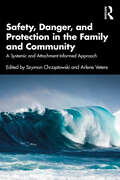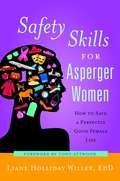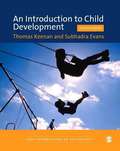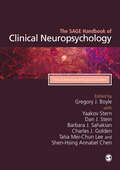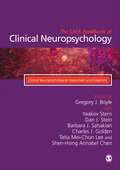- Table View
- List View
Safety, Danger, and Protection in the Family and Community: A Systemic and Attachment-Informed Approach
This book provides an analysis of the meaning of safety and security across the contexts of community and public life, throughout the life span, and within a therapeutic framework, examining threats and the strategies for coping with them. The book starts in Part I with a discussion of general safety and security concepts in the socio-cultural context. Part II of the book details the role of a sense of security in psychological assistance, psychotherapy and supervision, while Part III centres on safety and security at different life stages. Drawing on the tenets of modern attachment theory and trauma theory, chapter authors address questions of safety, danger, and protection for both individuals and groups, across a variety of fields of knowledge and expertise. Themes such as loneliness, play and exploration, evil and forgiveness, health and death, and spirituality and healing are discussed as practice examples, learning points, and tips. A wide range of health and social care professional practitioners will find this book useful in exploring social, interpersonal, and psychological aspects of safety and security.
Safety-II in Practice: Developing the Resilience Potentials
by Erik HollnagelSafety-I is defined as the freedom from unacceptable harm. The purpose of traditional safety management is therefore to find ways to ensure this ‘freedom’. But as socio-technical systems steadily have become larger and less tractable, this has become harder to do. Resilience engineering pointed out from the very beginning that resilient performance - an organisation’s ability to function as required under expected and unexpected conditions alike – required more than the prevention of incidents and accidents. This developed into a new interpretation of safety (Safety-II) and consequently a new form of safety management. Safety-II changes safety management from protective safety and a focus on how things can go wrong, to productive safety and a focus on how things can and do go well. For Safety-II, the aim is not just the elimination of hazards and the prevention of failures and malfunctions but also how best to develop an organisation’s potentials for resilient performance – the way it responds, monitors, learns, and anticipates. That requires models and methods that go beyond the Safety-I toolbox. This book introduces a comprehensive approach for the management of Safety-II, called the Resilience Assessment Grid (RAG). It explains the principles of the RAG and how it can be used to develop the resilience potentials. The RAG provides four sets of diagnostic and formative questions that can be tailored to any organisation. The questions are based on the principles of resilience engineering and backed by practical experience from several domains. Safety-II in Practice is for both the safety professional and academic reader. For the professional, it presents a workable method (RAG) for the management of Safety-II, with a proven track record. For academic and student readers, the book is a concise and practical presentation of resilience engineering.
Safety-II in Practice: Developing the Resilience Potentials
by Erik HollnagelSafety-I is defined as the freedom from unacceptable harm. The purpose of traditional safety management is therefore to find ways to ensure this ‘freedom’. But as socio-technical systems steadily have become larger and less tractable, this has become harder to do. Resilience engineering pointed out from the very beginning that resilient performance - an organisation’s ability to function as required under expected and unexpected conditions alike – required more than the prevention of incidents and accidents. This developed into a new interpretation of safety (Safety-II) and consequently a new form of safety management. Safety-II changes safety management from protective safety and a focus on how things can go wrong, to productive safety and a focus on how things can and do go well. For Safety-II, the aim is not just the elimination of hazards and the prevention of failures and malfunctions but also how best to develop an organisation’s potentials for resilient performance – the way it responds, monitors, learns, and anticipates. That requires models and methods that go beyond the Safety-I toolbox. This book introduces a comprehensive approach for the management of Safety-II, called the Resilience Assessment Grid (RAG). It explains the principles of the RAG and how it can be used to develop the resilience potentials. The RAG provides four sets of diagnostic and formative questions that can be tailored to any organisation. The questions are based on the principles of resilience engineering and backed by practical experience from several domains. Safety-II in Practice is for both the safety professional and academic reader. For the professional, it presents a workable method (RAG) for the management of Safety-II, with a proven track record. For academic and student readers, the book is a concise and practical presentation of resilience engineering.
Safety or Profit?: International Studies in Governance, Change and the Work Environment (Work, Health and Environment Series)
by Theo Nichols David WaltersAs the title Safety or Profit? suggests, health and safety at work needs to be understood in the context of the wider political economy. This book brings together contributions informed by this view from internationally recognized scholars. It reviews the governance of health and safety at work, with special reference to Australia, Canada, Sweden, and the United Kingdom. Three main aspects are discussed. The restructuring of the labor market: this is considered with respect to precarious work and to gender issues and their implications for the health and safety of workers. The neoliberal agenda: this is examined with respect to the diminished power of organized labor, decriminalization, and new governance theory, including an examination of how well the health-and-safety-at-work regimes put in place in many industrial societies about forty years ago have fared and how distinctive the recent emphasis on self-regulation in several countries really is. The role of evidence: there is a dearth of evidence-based policy. The book examines how policy on health and safety at work is formulated at both company and state levels. Cases considered include the scant regard paid to evidence by an official inquiry into future strategy in Canada; the lack of evidence-based policy and the reluctance to observe the precautionary principle with respect to work-related cancer in the United Kingdom; and the failure to learn from past mistakes in the Deepwater Horizon disaster in the Gulf of Mexico.
Safety or Profit?: International Studies in Governance, Change and the Work Environment (Work, Health and Environment Series)
by Theo Nichols David WaltersAs the title Safety or Profit? suggests, health and safety at work needs to be understood in the context of the wider political economy. This book brings together contributions informed by this view from internationally recognized scholars. It reviews the governance of health and safety at work, with special reference to Australia, Canada, Sweden, and the United Kingdom. Three main aspects are discussed. The restructuring of the labor market: this is considered with respect to precarious work and to gender issues and their implications for the health and safety of workers. The neoliberal agenda: this is examined with respect to the diminished power of organized labor, decriminalization, and new governance theory, including an examination of how well the health-and-safety-at-work regimes put in place in many industrial societies about forty years ago have fared and how distinctive the recent emphasis on self-regulation in several countries really is. The role of evidence: there is a dearth of evidence-based policy. The book examines how policy on health and safety at work is formulated at both company and state levels. Cases considered include the scant regard paid to evidence by an official inquiry into future strategy in Canada; the lack of evidence-based policy and the reluctance to observe the precautionary principle with respect to work-related cancer in the United Kingdom; and the failure to learn from past mistakes in the Deepwater Horizon disaster in the Gulf of Mexico.
Safety Science Research: Evolution, Challenges and New Directions
by Jean-Christophe Le CozeSafety Science Research: Evolution, Challenges and New Directions provides a unique perspective into the latest developments of safety science by putting together, for the first time, a new generation of authors with some of the pioneers of the field. Forty years ago, research traditions were developed, including, among others, high-reliability organisations, cognitive system engineering or safety regulations. In a fast-changing world, the new generation introduces, in this book, new disciplinary insights, addresses contemporary empirical issues, develops new concepts and models while remaining critical of safety research practical ambitions. Their ideas are then reflected and discussed by some of the pioneers of safety science. Features Allows the reader to discover how contemporary safety issues are currently framed by a new generation of researchers, brought together for the first time Includes an introduction and guide to the development of safety science over the last four decades Features an extraordinary collection of expert contributors, including pioneers of safety research, reflecting the evolution of the discipline and offering insightful commentary on the current and future state of the field Serves as an invaluable reference and guide for safety professionals and students from any established disciplines such as sociology, engineering, psychology, political science or management as well as dedicated safety programmes Some figures in the eBook are in colour
Safety Science Research: Evolution, Challenges and New Directions
by Jean-Christophe Le CozeSafety Science Research: Evolution, Challenges and New Directions provides a unique perspective into the latest developments of safety science by putting together, for the first time, a new generation of authors with some of the pioneers of the field. Forty years ago, research traditions were developed, including, among others, high-reliability organisations, cognitive system engineering or safety regulations. In a fast-changing world, the new generation introduces, in this book, new disciplinary insights, addresses contemporary empirical issues, develops new concepts and models while remaining critical of safety research practical ambitions. Their ideas are then reflected and discussed by some of the pioneers of safety science. Features Allows the reader to discover how contemporary safety issues are currently framed by a new generation of researchers, brought together for the first time Includes an introduction and guide to the development of safety science over the last four decades Features an extraordinary collection of expert contributors, including pioneers of safety research, reflecting the evolution of the discipline and offering insightful commentary on the current and future state of the field Serves as an invaluable reference and guide for safety professionals and students from any established disciplines such as sociology, engineering, psychology, political science or management as well as dedicated safety programmes Some figures in the eBook are in colour
Safety Skills for Asperger Women: How to Save a Perfectly Good Female Life
by Liane Holliday Willey Tony AttwoodLife with Asperger's Syndrome can be a challenge at the best of times, and trials and tribulations that neurotypicals take in their stride can leave Aspies perplexed and unsure of how best to solve problems and keep themselves safe, both physically and emotionally. This book explores difficulties that those with AS may face, and suggests practical and helpful ways of overcoming them. Liane Holliday Willey's positive and encouraging advice teaches people with Asperger Syndrome how to appreciate their differences and work from their strengths, by being honest about and coping with challenges. By setting realistic expectations, she shows how it can be possible to live on your own and take care of yourself, touching upon everything from banking and housing to roommates, friendships, and relationships. Jobs and the workplace are explored as advice is given on interviewing, performance, and getting along with colleagues, and the importance of setting boundaries is explained. The focus throughout is on keeping yourself safe, and this extends to travel, cultural awareness, and generally organising yourself. Personal hygiene and the body are also covered, along with nutrition and illness. The advice all adds up to show that people with AS can safeguard themselves from emotional and physical harm and live happy and independent lives, as long as the right guidance is available. This book will be of interest to people with Asperger Syndrome, their friends and families, and professionals working alongside ASDs.
Safety Skills for Asperger Women: How to Save a Perfectly Good Female Life (PDF)
by Liane Holliday Willey Tony AttwoodLife with Asperger's Syndrome can be a challenge at the best of times, and trials and tribulations that neurotypicals take in their stride can leave Aspies perplexed and unsure of how best to solve problems and keep themselves safe, both physically and emotionally. This book explores difficulties that those with AS may face, and suggests practical and helpful ways of overcoming them. Liane Holliday Willey's positive and encouraging advice teaches people with Asperger Syndrome how to appreciate their differences and work from their strengths, by being honest about and coping with challenges. By setting realistic expectations, she shows how it can be possible to live on your own and take care of yourself, touching upon everything from banking and housing to roommates, friendships, and relationships. Jobs and the workplace are explored as advice is given on interviewing, performance, and getting along with colleagues, and the importance of setting boundaries is explained. The focus throughout is on keeping yourself safe, and this extends to travel, cultural awareness, and generally organising yourself. Personal hygiene and the body are also covered, along with nutrition and illness. The advice all adds up to show that people with AS can safeguard themselves from emotional and physical harm and live happy and independent lives, as long as the right guidance is available. This book will be of interest to people with Asperger Syndrome, their friends and families, and professionals working alongside ASDs.
Sag mal: Worauf es bei der Moderation von Gruppen ankommt (Psychologie für Studium und Beruf)
by Heidrun Schüler-Lubienetzki Ulf LubienetzkiLernen Sie in diesem anschaulichen Lehrbuch die Grundlagen und Techniken einer besonderen Form der Gesprächsführung kennen: der Moderation. Erfahren Sie, wie Moderation die Kommunikation und Zusammenarbeit in Gruppen unterstützt und die in der Gruppe vorhandenen Potenziale freisetzt.
SAGE Directions in Educational Psychology (PDF)
by Dr Neil J. SalkindEducational psychology is a broad field characterized by the study of individuals in educational settings and how they develop and learn. It incorporates information from such sub-disciplines such as developmental psychology, human development across the life span, curriculum and instruction, motivation, and measurement and assessment. Neil Salkind has mined the rich and extensive backlist of SAGE education and psychology journals to pull together a collection of almost 100 articles to be the definitive research resource on education psychology. Section One: Human Growth and Development focuses on the processes involved in human growth and development including ages and stages of development, different theoretical perspectives and the role and effectiveness of early intervention among other topics. Section Two: Cognition, Learning and Instruction concentrates on the mechanisms, through which individuals learn and retain information. Section Three: Motivation explores why individuals seek out goals and what the mechanisms are that characterize this search as it relates to learning. Section Four: Measurement, Assessment and Statistics looks at the topics that are critical to understanding individual differences, the growth in the use of computers as assessment tools, qualitative and quantitative methods, statistical techniques and evaluation.
Sage Foundations of Psychology series: An Introduction to Child Development (2nd edition) (PDF)
by Thomas Keenan Subhadra EvansThe Second Edition of An Introduction to Child Development has been fully updated to provide a comprehensive survey of the main areas of child development, from infancy through to adolescence. Equipping students with an appreciation of critical issues in the field and an understanding of empirical research that bears on the study of children, the text provides balanced coverage of topics and theoretical perspectives that represent both classic and cutting edge work in child development. In terms of new content, it now covers more on the biological foundations of development, plus new chapters on moral development and applied developmental psychology.
The SAGE Handbook of Applied Memory
by D Stephen Lindsay Timothy J Perfect"A fabulous collection of essays on memory in the real world. The leading scholars have been assembled to produce a volume that is intellectually rich, up-to-date, and truly important." - Elizabeth F. Loftus, Distinguished Professor, University of California, Irvine "An invaluable resource for anyone wishing to access the current state of knowledge of, or contemplating research into, the growing area of applied memory research." - Graham Davies, Editor, Applied Cognitive Psychology The SAGE Handbook of Applied Memory is the first of its kind to focus specifically on this vibrant and progressive field. It offers a broad and comprehensive coverage of recent theoretical and empirical research advances in the psychology of memory as they apply to a range of applied issues, and offers advanced students and researchers the opportunity to survey the literature in the psychology of memory across a range of applied domains. Arranged into four sections: Everyday Memory; Social and Individual Differences in Memory; Subjective Experience of Memory; and Eyewitness Memory, this handbook provides a comprehensive summary and evaluation of scientific memory research as well as theory in a broad range of applied topics including those in cognitive, forensic and experimental psychology. Brought together by world-leading scholars from across the globe, The SAGE Handbook of Applied Memory will be of great interest to all advanced students and academics with an interest in all aspects of applied memory.
The SAGE Handbook of Applied Memory (PDF)
by D Stephen Lindsay Timothy J Perfect"A fabulous collection of essays on memory in the real world. The leading scholars have been assembled to produce a volume that is intellectually rich, up-to-date, and truly important." - Elizabeth F. Loftus, Distinguished Professor, University of California, Irvine "An invaluable resource for anyone wishing to access the current state of knowledge of, or contemplating research into, the growing area of applied memory research." - Graham Davies, Editor, Applied Cognitive Psychology The SAGE Handbook of Applied Memory is the first of its kind to focus specifically on this vibrant and progressive field. It offers a broad and comprehensive coverage of recent theoretical and empirical research advances in the psychology of memory as they apply to a range of applied issues, and offers advanced students and researchers the opportunity to survey the literature in the psychology of memory across a range of applied domains. Arranged into four sections: Everyday Memory; Social and Individual Differences in Memory; Subjective Experience of Memory; and Eyewitness Memory, this handbook provides a comprehensive summary and evaluation of scientific memory research as well as theory in a broad range of applied topics including those in cognitive, forensic and experimental psychology. Brought together by world-leading scholars from across the globe, The SAGE Handbook of Applied Memory will be of great interest to all advanced students and academics with an interest in all aspects of applied memory.
The SAGE Handbook of Applied Social Psychology
by Kieran C. O'Doherty Darrin HodgettsIn the present epoch of global change, movement, interconnection and the intensification of social issues within and across many societies, applied social psychology is more relevant than ever. The SAGE Handbook of Applied Social Psychology offers an overview of the field and the disparate and evolving approaches. Through an international team of contributors, the handbook brings prominent research literature together and organises it around ten key areas: Part 01: Culture, race, indigeneity Part 02: Gender & Sexuality Part 03: Politics Part 04: Health and mental health Part 05: Work Part 06: Ageing Part 07: Communication Part 08: Education Part 09: Environment Part 10: Criminal Justice, Law, & Crime This handbook is a uniting and invigorating resource for the field of Applied Social Psychology.
The SAGE Handbook of Applied Social Psychology
by Kieran C. O'Doherty Darrin HodgettsIn the present epoch of global change, movement, interconnection and the intensification of social issues within and across many societies, applied social psychology is more relevant than ever. The SAGE Handbook of Applied Social Psychology offers an overview of the field and the disparate and evolving approaches. Through an international team of contributors, the handbook brings prominent research literature together and organises it around ten key areas: Part 01: Culture, race, indigeneity Part 02: Gender & Sexuality Part 03: Politics Part 04: Health and mental health Part 05: Work Part 06: Ageing Part 07: Communication Part 08: Education Part 09: Environment Part 10: Criminal Justice, Law, & Crime This handbook is a uniting and invigorating resource for the field of Applied Social Psychology.
The SAGE Handbook of Clinical Neuropsychology: Clinical Neuropsychological Disorders
by Gregory J. Boyle Yaakov Stern Dan J. Stein Barbara J. Sahakian Charles J. Golden Tatia Mei-Chun Lee Shen-Hsing Annabel ChenClinical Neuropsychology is a vast and varied field that focuses on the treatment, assessment and diagnosis of a range of cognitive disorders through a study and understanding of neuroanatomy and the relationship between the brain and human behavior. This handbook focuses on specific Neuropsychological disorders. It covers each of the classification systems involved before moving on to specific types of disorders from neurodevelopmental to neuropathological as well as brain injuries, trauma and neurodegenerative disorders. This handbook not only provides an in-depth overview of these Neuropsychological disorders, but also explores the history of the field as well its global challenges. The handbook is an essential tool for clinicians and scientists, as well as postgraduate students and researchers in a range of disciplines exploring the area. PART I BACKGROUND CONSIDERATIONS PART II NEURODEVELOPMENTAL DISORDERS PART III NEUROLOGICAL DISORDERS PART IV NEUROCOGNITIVE DISORDERS PART V TRAUMATIC BRAIN INJURY PART VI PSYCHIATRIC DISORDERS
The SAGE Handbook of Clinical Neuropsychology: Clinical Neuropsychological Disorders
by Gregory J. Boyle Yaakov Stern Dan J. Stein Barbara J. Sahakian Charles J. Golden Tatia Mei-Chun Lee Shen-Hsing Annabel ChenClinical Neuropsychology is a vast and varied field that focuses on the treatment, assessment and diagnosis of a range of cognitive disorders through a study and understanding of neuroanatomy and the relationship between the brain and human behavior. This handbook focuses on specific Neuropsychological disorders. It covers each of the classification systems involved before moving on to specific types of disorders from neurodevelopmental to neuropathological as well as brain injuries, trauma and neurodegenerative disorders. This handbook not only provides an in-depth overview of these Neuropsychological disorders, but also explores the history of the field as well its global challenges. The handbook is an essential tool for clinicians and scientists, as well as postgraduate students and researchers in a range of disciplines exploring the area. PART I BACKGROUND CONSIDERATIONS PART II NEURODEVELOPMENTAL DISORDERS PART III NEUROLOGICAL DISORDERS PART IV NEUROCOGNITIVE DISORDERS PART V TRAUMATIC BRAIN INJURY PART VI PSYCHIATRIC DISORDERS
The SAGE Handbook of Clinical Neuropsychology: Clinical Neuropsychological Assessment and Diagnosis
by Gregory J. Boyle Yaakov Stern Dan J. Stein Barbara J. Sahakian Charles J. Golden Tatia Mei-Chun Lee Shen-Hsing Annabel ChenClinical Neuropsychology is a vast and varied field that focuses on the treatment, assessment and diagnosis of a range of cognitive disorders through a study and understanding of neuroanatomy and the relationship between the brain and human behavior. This handbook focuses on the assessment, diagnosis and rehabilitation of cognitive disorders. It provides in-depth coverage on a variety of content, including psychometrics, neuropsychological test batteries (computer based cognitive assessment systems) and assessment applications. This handbook is vital for clinical neuropsychologists and postgraduate students and researchers hoping to apply a knowledge of neuropsychology to clinical settings and effectively assess, diagnose and treat patients suffering from cognitive disorders. PART I BACKGROUND CONSIDERATIONS PART II DOMAIN-SPECIFIC NEUROPSYCHOLOGICAL MEASURES PART III GENERAL COGNITIVE TEST BATTERIES PART IV LEGACY NEUROPSYCHOLOGICAL TEST BATTERIES PART V COMPUTERISED BATTERIES, TECHNOLOGICAL ADVANCES AND TELENEUROPSYCHOLOGY PART VI NEUROPSYCHOLOGICAL ASSESSMENT APPLICATIONS
The SAGE Handbook of Clinical Neuropsychology: Clinical Neuropsychological Assessment and Diagnosis
by Gregory J. Boyle Yaakov Stern Dan J. Stein Barbara J. Sahakian Charles J. Golden Tatia Mei-Chun Lee Shen-Hsing Annabel ChenClinical Neuropsychology is a vast and varied field that focuses on the treatment, assessment and diagnosis of a range of cognitive disorders through a study and understanding of neuroanatomy and the relationship between the brain and human behavior. This handbook focuses on the assessment, diagnosis and rehabilitation of cognitive disorders. It provides in-depth coverage on a variety of content, including psychometrics, neuropsychological test batteries (computer based cognitive assessment systems) and assessment applications. This handbook is vital for clinical neuropsychologists and postgraduate students and researchers hoping to apply a knowledge of neuropsychology to clinical settings and effectively assess, diagnose and treat patients suffering from cognitive disorders. PART I BACKGROUND CONSIDERATIONS PART II DOMAIN-SPECIFIC NEUROPSYCHOLOGICAL MEASURES PART III GENERAL COGNITIVE TEST BATTERIES PART IV LEGACY NEUROPSYCHOLOGICAL TEST BATTERIES PART V COMPUTERISED BATTERIES, TECHNOLOGICAL ADVANCES AND TELENEUROPSYCHOLOGY PART VI NEUROPSYCHOLOGICAL ASSESSMENT APPLICATIONS
The SAGE Handbook of Clinical Neuropsychology: Clinical Neuropsychological Disorders
Clinical Neuropsychology is a vast and varied field that focuses on the treatment, assessment and diagnosis of a range of cognitive disorders through a study and understanding of neuroanatomy and the relationship between the brain and human behavior. This handbook focuses on specific Neuropsychological disorders. It covers each of the classification systems involved before moving on to specific types of disorders from neurodevelopmental to neuropathological as well as brain injuries, trauma and neurodegenerative disorders. This handbook not only provides an in-depth overview of these Neuropsychological disorders, but also explores the history of the field as well its global challenges. The handbook is an essential tool for clinicians and scientists, as well as postgraduate students and researchers in a range of disciplines exploring the area. PART I BACKGROUND CONSIDERATIONS PART II NEURODEVELOPMENTAL DISORDERS PART III NEUROLOGICAL DISORDERS PART IV NEUROCOGNITIVE DISORDERS PART V TRAUMATIC BRAIN INJURY PART VI PSYCHIATRIC DISORDERS
The SAGE Handbook of Clinical Neuropsychology: Clinical Neuropsychological Assessment and Diagnosis
Clinical Neuropsychology is a vast and varied field that focuses on the treatment, assessment and diagnosis of a range of cognitive disorders through a study and understanding of neuroanatomy and the relationship between the brain and human behavior. This handbook focuses on the assessment, diagnosis and rehabilitation of cognitive disorders. It provides in-depth coverage on a variety of content, including psychometrics, neuropsychological test batteries (computer based cognitive assessment systems) and assessment applications. This handbook is vital for clinical neuropsychologists and postgraduate students and researchers hoping to apply a knowledge of neuropsychology to clinical settings and effectively assess, diagnose and treat patients suffering from cognitive disorders. PART I BACKGROUND CONSIDERATIONS PART II DOMAIN-SPECIFIC NEUROPSYCHOLOGICAL MEASURES PART III GENERAL COGNITIVE TEST BATTERIES PART IV LEGACY NEUROPSYCHOLOGICAL TEST BATTERIES PART V COMPUTERISED BATTERIES, TECHNOLOGICAL ADVANCES AND TELENEUROPSYCHOLOGY PART VI NEUROPSYCHOLOGICAL ASSESSMENT APPLICATIONS
The SAGE Handbook of Coaching
by Tatiana Bachkirova Gordon Spence Dr David DrakeThe SAGE Handbook of Coaching presents a comprehensive, global view of the discipline, identifying the current issues and practices, as well as mapping out where the discipline is going. The Handbook is organized into six thematic sections: Part One: Positioning Coaching as a Discipline Part Two: Coaching as a Process Part Three: Common Issues in Coaching Part Four: Coaching in Contexts Part Five: Researching Coaching Part Six: Development of Coaches It provides the perfect reference point for graduate students, scholars, educators and researchers wishing to familiarize themselves with current research and debate in the academic and influential practitioners' literature on coaching.
The SAGE Handbook of Coaching
by Dr David Drake Gordon Spence Tatiana BachkirovaThe SAGE Handbook of Coaching presents a comprehensive, global view of the discipline, identifying the current issues and practices, as well as mapping out where the discipline is going. The Handbook is organized into six thematic sections: Part One: Positioning Coaching as a Discipline Part Two: Coaching as a Process Part Three: Common Issues in Coaching Part Four: Coaching in Contexts Part Five: Researching Coaching Part Six: Development of Coaches It provides the perfect reference point for graduate students, scholars, educators and researchers wishing to familiarize themselves with current research and debate in the academic and influential practitioners' literature on coaching.
The SAGE Handbook of Coaching (PDF)
by Dr David Drake Gordon Spence Tatiana BachkirovaThe SAGE Handbook of Coaching presents a comprehensive, global view of the discipline, identifying the current issues and practices, as well as mapping out where the discipline is going. The Handbook is organized into six thematic sections: Part One: Positioning Coaching as a Discipline Part Two: Coaching as a Process Part Three: Common Issues in Coaching Part Four: Coaching in Contexts Part Five: Researching Coaching Part Six: Development of Coaches It provides the perfect reference point for graduate students, scholars, educators and researchers wishing to familiarize themselves with current research and debate in the academic and influential practitioners' literature on coaching.
